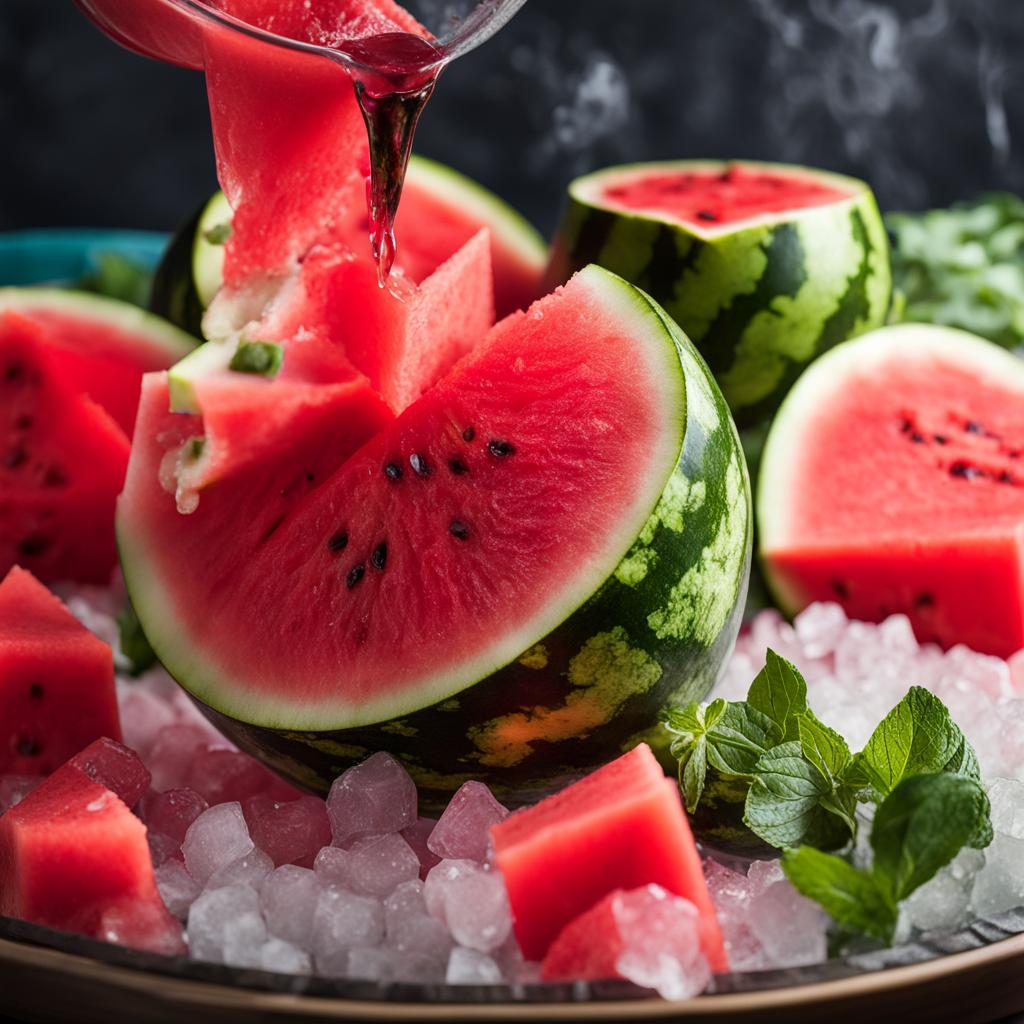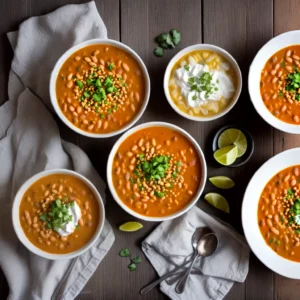Knowing how to pick a perfectly ripe watermelon is key to enjoying the sweetest and most flavorful fruit. By following a few simple tips, you can ensure that you choose the juiciest melon every time. The color, texture, firmness, and sound of the watermelon are all indicators of its ripeness.
Key Takeaways:
- Pay attention to the color and pattern of the watermelon’s stripes.
- Examine the field spot to determine its ripeness.
- Inspect the stem for clues about the melon’s flavor.
- Try the thumping method to listen for a hollow sound.
- Look for dry weathering spots on the surface for extra sweetness.
Checking the Color and Pattern
When it comes to determining the ripeness of a watermelon, one important factor to consider is its color and pattern. The color and pattern of a watermelon can give you valuable clues about its ripeness and overall quality.
Look for a watermelon that has a strong, consistent stripe pattern. The green stripes should be a deep, dark green, while the pale stripes should be a creamy, light yellow. This color combination indicates that the melon is likely ripe and ready to be enjoyed.
Avoid watermelons that have a shiny appearance, as this indicates that they are underripe. A dull, matte finish is a better indication of ripeness. Remember, it’s all about finding that perfect balance of colors!
Table: Watermelon Color and Ripeness Indicators
| Color | Ripeness Indicator |
|---|---|
| Deep, dark green stripes | Likely ripe |
| Creamy, light yellow stripes | Likely ripe |
| Shiny appearance | Underripe |
| Dull, matte finish | Potentially ripe |
Remember, when it comes to color and pattern, consistency is key. Look for those vibrant stripes and matte finish to select a ripe and delicious watermelon.
Examining the Field Spot
When it comes to picking a perfectly ripe watermelon, one of the key indicators to look for is the field spot. The field spot refers to the large discolored area on the surface of the watermelon. By examining the color of this spot, you can get a good idea of the fruit’s ripeness.
For a truly ripe watermelon, the field spot should be a creamy yellow or near orange color. This indicates that the melon is full of flavor and sweetness. On the other hand, if the field spot is white or light yellow, it suggests that the watermelon may not be fully ripe and could lack flavor. So, when choosing a watermelon, be sure to examine the field spot closely.
While the field spot is an important indicator, it’s also essential to consider other factors like color, texture, firmness, and sound to ensure you select the juiciest and most flavorful watermelon.
| Field Spot Color | Ripeness |
|---|---|
| Creamy yellow or near orange | Fully ripe and flavorful |
| White or light yellow | May not be fully ripe and could lack flavor |
Remember, a watermelon with a vibrant and ripe field spot is more likely to offer a burst of juicy sweetness in every bite. So, the next time you’re at the grocery store or farmer’s market, be sure to give the field spot the attention it deserves when selecting your watermelon.
Inspecting the Stem
When it comes to picking a perfectly ripe watermelon, don’t forget to inspect the stem. The stem can provide valuable clues about the fruit’s ripeness and flavor. A dry and yellow-brown stem indicates that the watermelon has had sufficient time to ripen and will be sweet and flavorful.
On the other hand, a green stem suggests that the watermelon is not yet ripe and may lack flavor and sweetness. So be sure to look for a watermelon with a dry and yellow-brown stem when you’re making your selection.
Remember, the stem is just one of several indicators of ripeness, so it’s important to consider other factors such as color, texture, firmness, and sound as well.
Using the Thumping Method
When it comes to picking a watermelon, one popular method to determine its ripeness is by using the thumping technique. While this method may seem old-fashioned, it can provide valuable insights into the fruit’s quality and taste.
Here’s how you can use the thumping method to select the perfect watermelon:
- Start by gently tapping the watermelon with your knuckles or the palm of your hand.
- Listen closely to the sound it produces. A ripe and juicy watermelon will typically produce a deep, hollow sound.
- On the other hand, an underripe watermelon will give off a higher-pitched and denser sound, indicating that it may not be fully ripened.
By paying attention to the sound, you can get an idea of the watermelon’s water content and ripeness. Remember, a deep and hollow sound is a good indication that the melon is ripe and ready to enjoy.
“Thumping a watermelon is like knocking on its door and listening for a response. The right sound can unlock a world of sweet, juicy goodness!”
Thumping Method Pros and Cons
While the thumping method can be helpful, it’s important to note that it may not always be foolproof. The sound produced can vary depending on the individual watermelon and other factors, such as its size and thickness of the rind. Additionally, it may take some practice to differentiate between the different sounds and determine the ripeness accurately.
Therefore, it’s beneficial to combine the thumping method with other indicators of ripeness, such as examining the color, texture, field spot, stem, and weight. By considering all these factors, you can increase your chances of picking a perfectly ripe and delicious watermelon.
| Pros | Cons |
|---|---|
|
|
Remember, the thumping method is just one tool in your watermelon-picking arsenal. Combine it with other techniques, trust your senses, and enjoy the deliciousness of perfectly ripe watermelon all summer long!
Observing the Dry Weathering Spots
When selecting a watermelon, it’s essential to consider all the factors that indicate ripeness. One often overlooked indicator is the presence of dry weathering spots on the watermelon’s surface. These spots are not imperfections but rather areas where sugar has seeped out of the fruit, making it even sweeter and more delicious. By observing these spots, you can ensure that you choose a watermelon that is bursting with sweetness.
Take a close look at the watermelon’s skin and inspect all sides of the melon. Look for webbing lines, sometimes referred to as vein-like patterns, as they are often associated with dry weathering spots. These spots can vary in size and shape, but they are distinguishable by their lighter color and drier texture compared to the rest of the skin. The presence of these spots indicates that the watermelon has reached a high level of sweetness.
“Dry weathering spots on a watermelon are a sign that the fruit has reached peak ripeness. These spots show where sugar has concentrated in the melon, resulting in a sweeter and more flavorful eating experience.”
When choosing a watermelon based on dry weathering spots, it’s important to note that not all watermelons will have them. The presence of these spots can vary depending on factors like growing conditions and the specific variety of watermelon. Therefore, it’s a good idea to consider them along with other ripeness indicators to make an informed decision.
| Dry Weathering Spot | Ripeness Level |
|---|---|
| Multiple large spots | Very ripe and sweet |
| Several small spots | Ripe and sweet |
| No or minimal spots | May still be ripe, but less sweet |
Remember, dry weathering spots are just one aspect to consider when choosing a ripe watermelon. By combining this indicator with others, such as color, texture, firmness, and sound, you can have confidence in your selection and enjoy the juiciest and most flavorful watermelon possible.

Feeling the Weight
When it comes to selecting a perfectly ripe watermelon, one useful tip is to pay attention to its weight. By evaluating the weight of the watermelon, you can determine its juiciness and ripeness. A heavier watermelon tends to have a higher water content, resulting in a sweeter and more flavorful melon.
To gauge the weight, simply lift the watermelon in your hands and compare it to others of similar size. A ripe watermelon should feel heavier than it looks. This is because the water content within the melon contributes to its weight. So, when you’re picking out a watermelon, go for the one that feels the heaviest for its size.
By choosing a watermelon with a substantial weight, you can ensure that you’re getting a juicy and delicious fruit that is bursting with flavor. So, next time you’re at the store or farmer’s market, don’t forget to feel the weight of the watermelon before making your selection.
Remember: a heavier watermelon indicates a higher water content and a sweeter taste.
Choosing the Right Shape
When it comes to selecting a watermelon, the shape can actually give you valuable insights into its ripeness and flavor. Generally, rounder melons tend to be sweeter, while more oval-shaped ones can be less flavorful and have a higher water content. So, if you’re aiming for the sweetest and juiciest watermelon, opt for a rounder shape.
Additionally, it’s important to avoid melons with irregular lumps or bumps on the surface. These irregularities can indicate that the watermelon has not grown evenly, potentially affecting its taste and texture. By choosing a watermelon with a smooth and consistent surface, you can ensure a more enjoyable eating experience.
Remember, the shape of the watermelon is just one factor to consider when determining its ripeness. Be sure to combine this knowledge with other indicators, such as color, texture, firmness, and sound, for a more comprehensive assessment.
Table: Watermelon Shape and Flavor
| Watermelon Shape | Flavor |
|---|---|
| Round | Sweeter and more flavorful |
| Oval | Higher water content, less flavorful |
Summary:
- Round watermelons tend to be sweeter, while oval-shaped ones may have a higher water content and be less flavorful.
- Avoid watermelons with irregular lumps or bumps on their surface.
- Consider the shape along with other indicators of ripeness, such as color, texture, firmness, and sound.
Optimal Time to Buy Watermelon
When it comes to purchasing watermelons, timing is everything. To ensure you get the juiciest and most flavorful fruit, it’s important to know the optimal time to buy watermelons. The peak season for watermelons typically lasts from May to September, so this is when you’ll find the best selection and quality.
During the peak season, watermelons are at their ripest and most abundant. They are harvested at their optimal stage of ripeness, resulting in sweet, juicy melons that are bursting with flavor. Whether you’re planning to enjoy watermelon on its own or use it in recipes, buying during the peak season guarantees the best taste and quality.
One advantage of buying watermelons during the peak season is the variety of options available. You’ll find different types of watermelons, such as seedless, mini, and traditional varieties, giving you the opportunity to choose the one that suits your preferences. Whether you prefer a smaller size, seedless variety, or the classic large watermelon, you’ll find a wide range of options during the peak season.
So, when you’re in the market for a watermelon, be sure to plan your purchase during the peak season from May to September. This way, you’ll have the best chance of finding a ripe, sweet, and delicious watermelon that will be the highlight of your summer gatherings and refreshing treats.
| Benefits of Buying Watermelon During Peak Season |
|---|
| Freshest and most flavorful watermelons |
| Wide variety of watermelon options |
| Guaranteed optimal ripeness |
| Abundant supply of watermelons |
Storing Watermelon
When it comes to storing watermelon, there are a few important factors to consider to ensure its freshness and optimal flavor. Here are some tips on how to properly store your watermelons:
Room Temperature for Whole Melons
Whole, uncut watermelons should be kept at room temperature. This allows the melons to ripen further and maintain their sweetness. Find a cool spot in your kitchen or pantry away from direct sunlight and heat sources.
Refrigeration for Cut Watermelon
Once you’ve cut into a watermelon, it’s best to refrigerate the remaining pieces to preserve their juiciness. Place the cut watermelon in an airtight container or cover it tightly with plastic wrap. This helps prevent the flesh from drying out and extends its shelf life.
Shelf Life
Uncut watermelons can last for 7 to 10 days when stored at room temperature. However, keep in mind that the shelf life may vary depending on the ripeness of the melon when purchased. Cut watermelon, when properly refrigerated, can stay fresh for about 3 to 4 days.
| Storage Method | Shelf Life |
|---|---|
| Uncut at room temperature | 7 to 10 days |
| Cut and refrigerated | 3 to 4 days |
Remember, these guidelines are general recommendations, and the specific shelf life of a watermelon can depend on various factors such as its ripeness, storage conditions, and overall quality. It’s always best to use your senses and common sense when assessing the freshness of your watermelon.
Now that you know how to store watermelon properly, you can enjoy its refreshing and sweet flavor for longer periods. Whether you’re making a delicious fruit salad or enjoying a slice on a hot summer day, properly storing your watermelon will ensure a delightful and juicy experience.
Freezing Watermelon

When it comes to extending the shelf life of watermelon, freezing is a great option. Although the texture may change once thawed, frozen watermelon can still be used in various recipes, particularly in refreshing beverages and icy treats.
To freeze watermelon, start by cutting it into bite-sized pieces. Spread the pieces out on a baking sheet lined with parchment paper to prevent sticking, and place it in the freezer for a few hours. Once the watermelon is frozen, transfer the pieces to an airtight container or freezer bag to prevent freezer burn.
When you’re ready to use the frozen watermelon, simply thaw it in the refrigerator or enjoy it straight from the freezer. Frozen watermelon can be added to smoothies, blended into slushies, or used as ice cubes in your favorite summer drinks. Get creative and experiment with different flavor combinations to create refreshing and delicious treats.
Table: Ideas for Using Frozen Watermelon
| Recipes | Beverages |
|---|---|
| Watermelon sorbet | Watermelon margarita |
| Watermelon smoothie bowl | Watermelon lemonade |
| Watermelon popsicles | Watermelon mojito |
Tip: To enhance the flavor of your frozen watermelon treats, try adding a squeeze of fresh lime juice or a sprinkle of mint leaves.
With frozen watermelon on hand, you can enjoy the taste of summer all year round. So the next time you have an abundance of watermelon, don’t let it go to waste – freeze it for a refreshing treat whenever you crave something cool and sweet!
What to Do with Watermelon Rinds
While many people are familiar with enjoying the juicy flesh of a watermelon, few realize that the rinds can also be put to good use. Don’t let those rinds go to waste! In fact, pickled watermelon rinds are a popular delicacy in the South, offering a unique combination of sweet, tangy, and savory flavors. By following a simple pickling recipe, you can transform watermelon rinds into a delicious and versatile condiment that can be added to various dishes.
To pickle watermelon rinds, start by cutting away the green skin and any red flesh, leaving only the white part. Then, cut the rind into small, bite-sized pieces and place them in a sterilized jar. In a saucepan, combine vinegar, sugar, and spices like cloves, cinnamon, and ginger. Heat the mixture until the sugar dissolves and the flavors meld together.
Pour the hot pickling liquid over the watermelon rinds in the jar, making sure they are completely submerged. Seal the jar tightly and let it cool to room temperature, then refrigerate for at least 24 hours to allow the flavors to develop. The pickled watermelon rinds can be enjoyed on their own as a tangy snack or used as a topping for sandwiches, tacos, salads, or even hot dogs. Get creative and experiment with different recipes that incorporate these delicious and unexpected flavors.
So the next time you find yourself with leftover watermelon rinds, don’t discard them. Give pickling a try and discover a whole new world of taste and texture. It’s a sustainable way to make the most out of every part of the watermelon and add a unique touch to your culinary creations.
Table: Watermelon Rinds Pickling Recipe
| Ingredients | Amount |
|---|---|
| Watermelon rinds | 4 cups |
| Vinegar | 2 cups |
| Sugar | 2 cups |
| Cloves | 6 whole |
| Cinnamon | 2 sticks |
| Ginger | 1 knob, sliced |
Instructions:
- Cut away the green skin and any red flesh from the watermelon rinds, leaving only the white part.
- Cut the rinds into small, bite-sized pieces and place them in a sterilized jar.
- In a saucepan, combine vinegar, sugar, cloves, cinnamon, and ginger. Heat the mixture until the sugar dissolves.
- Pour the hot pickling liquid over the watermelon rinds, ensuring they are completely submerged.
- Seal the jar tightly and let it cool to room temperature.
- Refrigerate the jar for at least 24 hours before enjoying the pickled watermelon rinds.
Conclusion
Picking a watermelon at its peak ripeness is a delightful skill that can be honed with practice. By carefully observing the color, texture, firmness, and sound of the watermelon, you can ensure that it is a sweet and juicy treat. Remember to pay attention to the field spot, stem, and dry weathering spots as additional indicators of ripeness.
When selecting a watermelon, aim for the perfect balance of sweetness and juiciness. By using these ripeness indicators, you can avoid disappointment and enjoy the best flavors that watermelon has to offer. Whether you’re planning refreshing summer salads, chilled beverages, or fruity desserts, a perfectly ripe watermelon will elevate your culinary creations.
Next time you’re at the store or farmer’s market, put these tips into practice. I guarantee that with a little practice and attention to detail, you’ll become a watermelon picking pro. So go ahead, pick a watermelon that’s ripe, full of sweetness, and bursting with juiciness. Your taste buds will thank you!
FAQ
How can I tell if a watermelon is ripe?
There are several indicators of ripeness to look for when selecting a watermelon. These include the color, texture, firmness, and sound of the melon. Pay attention to these factors to ensure you choose a ripe and delicious watermelon.
What should I look for in the color and pattern of a watermelon?
Look for a watermelon with a strong, consistent stripe pattern. The green stripes should be a deep, dark green, while the pale stripes should be a creamy, light yellow. Avoid melons with a shiny appearance, as this indicates they are underripe.
How does the field spot indicate watermelon ripeness?
The field spot, or large discolored spot on the surface of the watermelon, is an important indicator of ripeness. The color of the field spot should be a creamy yellow or near orange, which suggests the melon is full of flavor. A white or light yellow field spot indicates the watermelon lacks flavor and may not be fully ripe.
What can the stem tell me about a watermelon’s ripeness?
The stem of a watermelon can provide insight into its ripeness. A dry and yellow-brown stem indicates the melon has had sufficient time to ripen and will be sweet and flavorful. A green stem suggests the watermelon is not yet ripe and may lack flavor and sweetness.
Does thumping a watermelon really help determine its ripeness?
Yes, thumping can be a useful method for assessing watermelon ripeness. Give the watermelon a gentle tap and listen to the sound it produces. A deep and hollow sound indicates the melon has more water content and is likely ripe. A higher-pitched and denser sound suggests the melon is not fully ripened and may have a thicker rind.
What are the dry weathering spots on a watermelon’s surface?
Dry weathering spots and vein-like webbing lines on the watermelon’s surface indicate extra sweetness. These spots show where sugar has seeped out of the fruit, making it even sweeter. Inspect all sides of the melon for these spots before making your selection.
Does the weight of a watermelon indicate its juiciness?
Yes, the weight of a watermelon can give you an indication of its juiciness. When picking up a watermelon, it should feel heavier than it looks. The denser it is for its size, the higher the water content, resulting in a sweeter melon. Pick the heaviest one for its size to ensure a juicy and delicious watermelon.
Does the shape of a watermelon affect its taste?
Yes, the shape of a watermelon can impact its taste. Rounder melons are generally sweeter, while more oval-shaped melons may be watery and less flavorful. Additionally, it’s best to avoid melons with irregular lumps or bumps on the surface.
When is the best time to buy a watermelon?
The peak season for watermelon is typically from May to September. Watermelons are most flavorful and abundant during this time. Take advantage of this season to pick the best and ripest watermelons for your enjoyment.
How should I store whole and cut watermelon?
Whole, uncut watermelons should be kept at room temperature to maintain their sweetness and flavor. Once a watermelon is cut, it should be refrigerated to prevent it from drying out and spoiling. Uncut watermelons can last on the counter for 7 to 10 days, while cut watermelon is good in the refrigerator for 3 to 4 days.
Can watermelon be frozen?
Yes, you can freeze watermelon. While the texture may change once thawed, frozen watermelon can be used in recipes like slushies or as ice cubes for drinks. Freezing is a great way to extend the shelf life of watermelon and have it on hand for future culinary creations.
What can I do with watermelon rinds?
Don’t throw away watermelon rinds! In the South, pickled watermelon rinds are a popular delicacy. They can be made into a relish and added to various dishes. So instead of wasting the rinds, consider trying out a pickling recipe to enjoy this unique culinary treat.
How can I pick a perfectly ripe watermelon?
Picking a perfectly ripe watermelon is a skill that can be acquired with practice. By paying attention to the color, texture, firmness, and sound of the watermelon, as well as considering factors like the field spot and weight, you can ensure that you choose a melon that is sweet, juicy, and full of flavor.
Source Links
- https://www.fifteenspatulas.com/how-to-pick-a-superstar-watermelon/
- https://www.realsimple.com/food-recipes/shopping-storing/food/how-to-pick-watermelon
- https://www.themediterraneandish.com/how-to-pick-a-watermelon/
Related Recipes:
 Watermelon Storage: Tips and Tricks
Watermelon Storage: Tips and Tricks
 Signs of a Bad Watermelon
Signs of a Bad Watermelon
 How to Cut a Watermelon: A Comprehensive Guide
How to Cut a Watermelon: A Comprehensive Guide
 How to Cut a Watermelon? (Perfect Step-By-Step Guide)
How to Cut a Watermelon? (Perfect Step-By-Step Guide)
 Signs of a Ripe Cantaloupe
Signs of a Ripe Cantaloupe
 How to Tell When Pomegranates are Ripe
How to Tell When Pomegranates are Ripe
 Identifying Ripe Bananas: A Quick Guide
Identifying Ripe Bananas: A Quick Guide
 The 5 best knives for carving turkey in 2023
The 5 best knives for carving turkey in 2023








